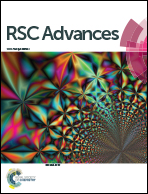Exploring the role of a single water molecule in the tropospheric reaction of glycolaldehyde with an OH radical: a mechanistic and kinetics study†
Abstract
The mechanism, thermochemistry and kinetics of hydrogen abstraction pathways in the atmospheric reaction of glycolaldehyde with a hydroxyl radical, in the absence and presence of a single-water molecule under tropospheric conditions, are investigated. The pathways are explored through high-level quantum mechanical computations employing a global reaction route mapping method at the levels of coupled-cluster and density-functional theories employing BHandHLYP and M06-2X exchange–correlation functionals. The reaction is found to be dominated by the hydrogen abstraction pathways involving the aldehydic site in glycolaldehyde, both in the presence and absence of water. The spin-density from the natural orbital analysis and molecular orbitals predict that a few of the pathways, water-free as well as with water, proceed through a proton-coupled electron-transfer mechanism rather than the conventional free radical mechanism. The overall rate constant for the water-free reaction at room temperature, calculated using the transition state theory, at the CCSD(T)//BHandHLYP level, is found to be in good agreement with the experimental results, though the rate constants corresponding to the water-assisted reaction are found to be smaller by several orders of magnitude, but M06-2X was observed to overestimate the rate constants. However, contrary to the negative temperature-dependence exhibited by the rate constants observed in the case of the water-free reaction, the water-assisted rate constants exhibit a correct Arrhenius behavior with significant tunneling at low temperatures. Notably, cis–trans interconversion in glycolaldehyde is observed to be feasible along the water-assisted pathways contrary to that along the water-free pathways. Besides this, the present work also explored an addition reaction pathway for the addition of a hydroxy radical to the carbonyl group of glycolaldehyde which can result in species like hydroxyl-formaldehyde, hydroxyl-methyl and a dihydroxy radical.



 Please wait while we load your content...
Please wait while we load your content...